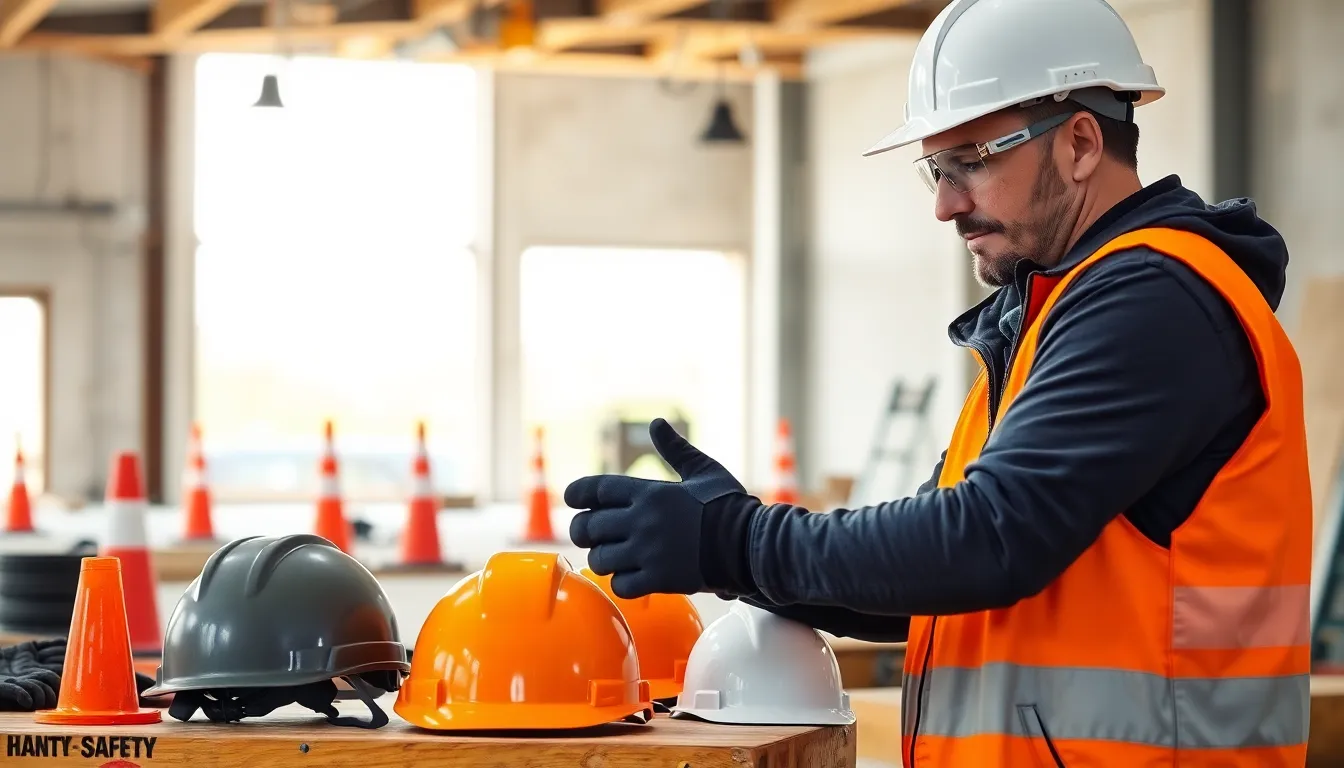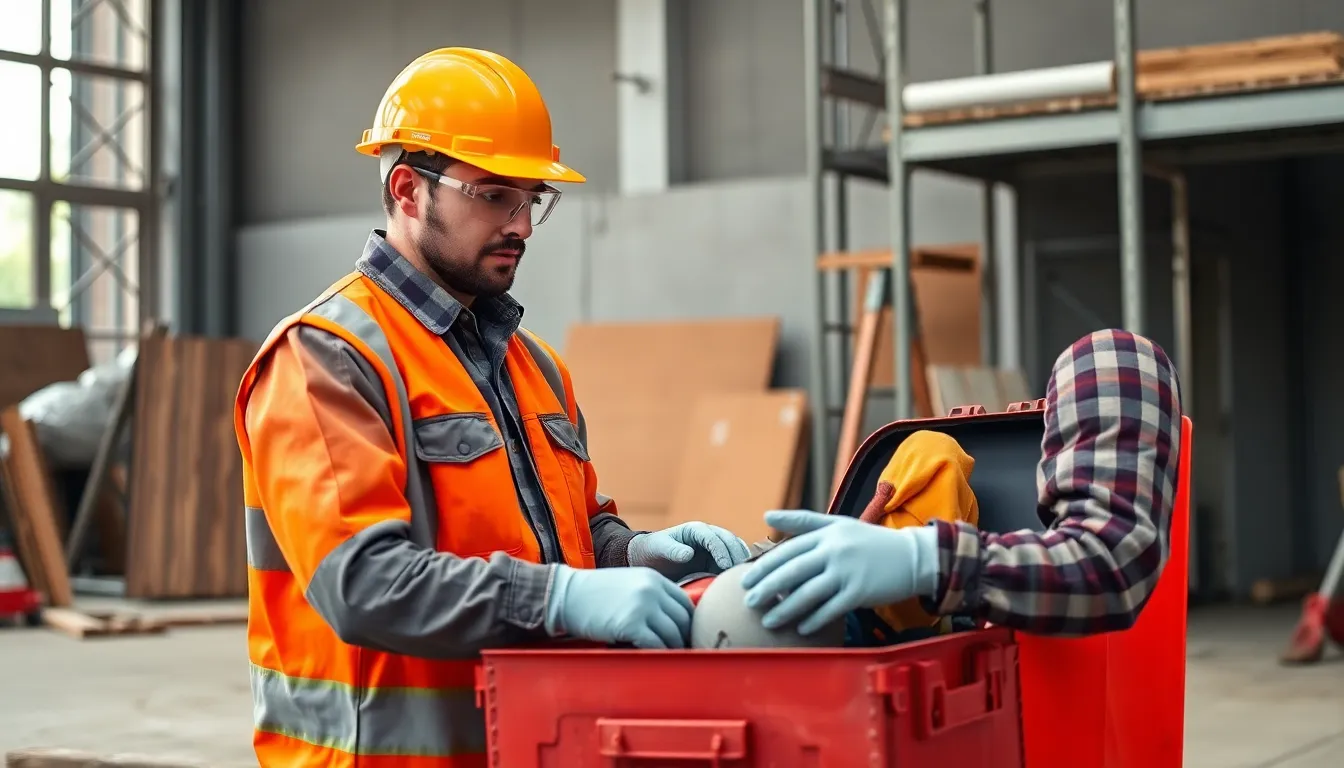In a world where accidents can strike faster than a cat video goes viral, safety equipment is the unsung hero we all need. Imagine a superhero who doesn’t wear a cape but instead dons a hard hat, goggles, and sturdy gloves. This trusty gear isn’t just for the clumsy—it’s essential for anyone who values their well-being.
Table of Contents
ToggleOverview of Safety Equipment
Safety equipment encompasses various tools designed to safeguard individuals from potential hazards. Essential gear includes hard hats, which protect against falling objects, and goggles, which shield eyes from debris and chemical splashes. Gloves play a critical role in protecting hands from injuries and chemical exposures.
Specific industries require tailored safety equipment. Construction sites often require durable footwear, while laboratories mandate the use of lab coats and face shields. Emergency responders utilize specialized gear like fire-resistant suits and protective breathing apparatus for high-risk situations.
Proper usage of safety equipment is vital for effective protection. Training programs often emphasize the correct ways to wear and maintain this gear. Compliance with safety regulations ensures that individuals remain within safe operational limits.
Workers should regularly inspect their equipment for damage or wear. Regular checks prevent accidents caused by malfunctioning or ineffective gear. Organizations promote safety by providing high-quality equipment and ongoing training to employees.
In many cases, safety equipment features innovative technologies that enhance protection. For example, helmets equipped with built-in communication systems allow workers to stay connected in noisy environments. Smart gloves with sensor technology ensure precision while protecting hands.
Adopting the right safety gear fosters a culture of safety within the workplace. When individuals prioritize their safety, they contribute to a safer environment for everyone. Investing in the proper equipment not only protects workers but also enhances overall productivity and morale.
Types of Safety Equipment


Safety equipment encompasses a wide range of tools designed to protect individuals in various environments. Understanding these types helps enhance workplace safety and minimizes risks.
Personal Protective Equipment (PPE)
Personal protective equipment includes essential items like helmets, gloves, and goggles. Helmets protect the head from falling objects and other impacts. Gloves shield hands from chemicals and cuts, while goggles prevent eye injuries from hazardous materials. This gear is crucial in industries like construction and manufacturing. Regular inspections ensure PPE remains effective and free from damage. Companies must train employees on proper usage to maximize safety benefits.
Fire Safety Equipment
Fire safety equipment plays a vital role in emergency preparedness. Fire extinguishers should be accessible and correctly maintained. Smoke detectors alert individuals to potential dangers, while fire blankets provide quick protection against flames. Each workplace must develop and practice evacuation plans, ensuring all employees know their roles in a fire emergency. Keeping fire exits clear and marked promotes safe escape routes during an event.
Environmental Safety Equipment
Environmental safety equipment focuses on protecting individuals from hazardous substances. Chemical spill kits allow for quick response to spills, minimizing contamination risks. Air quality monitors detect dangerous pollutants, fostering a safer work environment. Waste containers labeled for specific materials prevent improper disposal and protect the ecosystem. Regular training on environmental safety procedures equips employees to respond effectively in case of incidents.
Importance of Safety Equipment
Safety equipment plays a vital role in protecting individuals from workplace hazards. Proper gear not only safeguards workers but also promotes a culture of safety.
Protecting Workers
Protecting workers from injuries is the primary function of safety equipment. Hard hats shield against falling objects, while goggles prevent eye damage from chemicals or debris. Gloves offer hand protection when handling heavy or sharp items. Equipment tailored to specific jobs, like durable footwear for construction sites or lab coats for laboratories, enhances safety further. Regular training on using safety equipment ensures effective protection, reducing the likelihood of accidents.
Compliance with Regulations
Compliance with regulations mandates the use of safety equipment in most industries. Legislation, such as the Occupational Safety and Health Administration (OSHA) standards, sets requirements for safety gear to protect workers. Adhering to these regulations not only avoids legal penalties but also enhances workplace safety. Organizations that invest in compliant safety equipment demonstrate a commitment to employee well-being and foster a safer work environment. Regular audits and training sessions ensure that safety standards remain a priority in the workplace.
Choosing the Right Safety Equipment
Selecting appropriate safety equipment requires careful consideration of workplace hazards and individual needs. Each industry presents distinct risks that safety gear must address effectively.
Assessing Risks
Identifying potential hazards comes first in the process. This includes evaluating the environment, tasks, and materials involved. Use a risk assessment checklist to document identified dangers. Analyze each risk’s likelihood and consequence to prioritize safety measures. Tailoring safety gear to these risks enhances protection against injury. For instance, construction sites necessitate hard hats and steel-toed boots, while laboratories require gloves and goggles. The right equipment aligns with specific job requirements and minimizes injury potential.
Budget Considerations
Cost plays a significant role in selecting safety equipment. Organizations should balance quality and affordability. Investing in high-quality gear reduces the risk of equipment malfunction, ultimately saving costs from workplace injuries. Research market options to find durable equipment within budget constraints. Take into account training costs and ongoing maintenance for safety gear. Prioritizing compliance with safety regulations may incur upfront costs but offers long-term benefits. Choosing equipment that fits both safety requirements and budget ensures a sustainable approach to workplace protection.
Prioritizing safety equipment is crucial for anyone who values their well-being. From hard hats to specialized gloves each piece of gear serves a specific purpose in preventing injuries and ensuring a safe work environment. Investing in quality safety equipment not only complies with regulations but also demonstrates a commitment to employee protection.
Regular training and maintenance are key to maximizing the effectiveness of this equipment. By carefully assessing workplace hazards and selecting appropriate gear individuals and organizations can significantly reduce risks. Ultimately a proactive approach to safety equipment fosters a culture of safety that benefits everyone involved.


